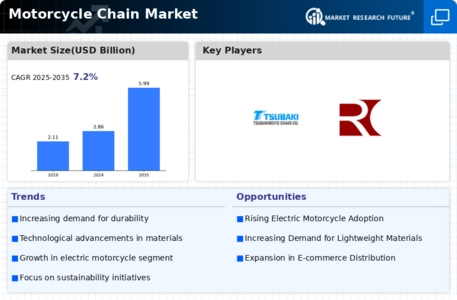Motorcycle Chain Size
Motorcycle Chain Market Growth Projections and Opportunities
The motorcycle chain market is a dynamic sector that experiences continuous shifts in demand and supply, driven by various market dynamics. One of the primary factors influencing this market is the global motorcycle industry's growth and evolution. As the motorcycle sector expands, so does the demand for components like chains, which play a crucial role in transmitting power from the engine to the wheels.
Consumer preferences and trends also significantly impact the motorcycle chain market. Changing consumer demands for specific features, such as durability, reduced maintenance, and improved performance, drive manufacturers to innovate and develop advanced chain technologies. Additionally, the rising popularity of different types of motorcycles, including sport bikes, cruisers, and off-road bikes, contributes to the diversification of chain requirements, further shaping the market dynamics.
Economic factors play a vital role in the motorcycle chain market as well. Fluctuations in the global economy, currency exchange rates, and disposable income levels directly influence consumer purchasing power. During economic downturns, consumers may opt for more cost-effective and durable chain options, leading manufacturers to adjust their product offerings accordingly. Conversely, economic prosperity often prompts increased spending on premium and high-performance motorcycle chains.
Technological advancements are a driving force in the motorcycle chain market, with manufacturers constantly striving to enhance product performance and efficiency. Innovations such as low-friction coatings, improved materials, and advanced manufacturing processes contribute to the overall evolution of motorcycle chains. The integration of smart technologies, such as sensor-equipped chains for real-time monitoring of wear and tear, represents a futuristic trend that can further revolutionize the market dynamics.
Regulatory changes also influence the motorcycle chain market. Stringent environmental regulations and emission standards have led manufacturers to explore lightweight materials and alternative coatings to reduce the overall environmental impact of motorcycles, indirectly affecting the design and composition of chains. Compliance with safety standards is another critical aspect, prompting manufacturers to invest in research and development to create chains that meet or exceed industry safety requirements.
Competitive dynamics play a crucial role in shaping the motorcycle chain market landscape. Intense competition among key players encourages continuous innovation and cost-effective solutions. Market leaders focus on strategic collaborations, mergers, and acquisitions to strengthen their market presence and expand their product portfolios. This competition fosters an environment where manufacturers are driven to offer superior products at competitive prices, benefiting consumers with a wide range of options.
Global supply chain disruptions and geopolitical events also impact the motorcycle chain market. The interconnected nature of the global economy means that any disruptions in the supply chain, such as raw material shortages or transportation challenges, can lead to fluctuations in product availability and pricing. Geopolitical tensions can affect trade relationships and impact the distribution networks, influencing market dynamics on a global scale.
In conclusion, the motorcycle chain market is a dynamic and multifaceted sector influenced by a combination of factors. From consumer preferences and economic conditions to technological advancements and regulatory changes, various dynamics shape the landscape of this market. Manufacturers must navigate these dynamics strategically to stay competitive and meet the evolving needs of the motorcycle industry and its diverse consumer base.










Leave a Comment